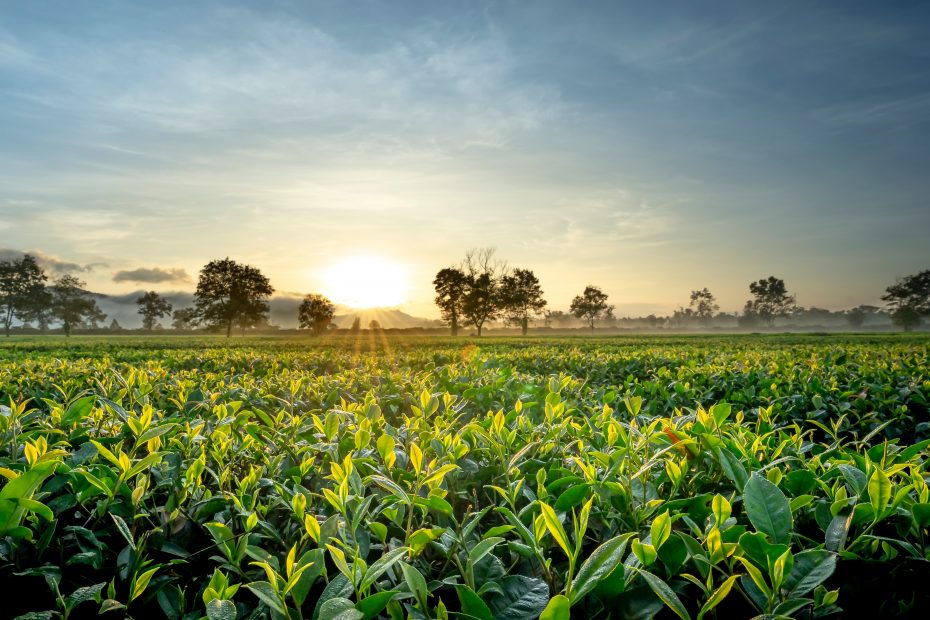Where Tea Is Grown Mostly?
Darjeeling
One of the 16 districts that collectively make up the federal state of West Bengal, the Darjeeling district in northern India spans a total area of about 3,000 square kilometers in the foothills of the Himalayas. To the north, the Teesta and Rangit rivers mark the border with Sikkim; to the west, Darjeeling borders Nepal; and to the east, the kingdom of Bhutan.
Until the mid-19th century, the place Darjeeling, which gave its name to the most famous tea in the world today, was still a barely visible dot on the map, used as a base by the army and inhabited by a few farmers .
The number of tea gardens increased steadily to 113 in the year 1874 after Dr. Campbell planted the first tea bushes at the Beechwood in 1847 and the first tea gardens (Tukvar, Steinthal, and Aloobari) became economically viable in 1852. Darjeeling tea is currently produced by over 65,000 employees from 86 tea estates across approximately 19,000 hectares during the peak season, depending on the weather.
Darjeeling is rightly identified as the champagne of tea, it is not only because only tea from this region is allowed to bear the name, but more importantly because at the altitude of 2,000 meters above sea level the tea grows very slowly, fully developing its particularly delicate aroma.
The First Flush (the first crop), is harvested from March to April and has a fresh, light and lively flavor. The first harvests are sent to the West in mid-May by air, and eagerly awaited by admirers.
Teas that are produced in April-May (middle harvest) still possess the freshness of the first crops, but anticipate the flavor of the second flush.
Second Flush (second tell), which is produced from mid-May to June, is smooth and aromatic with a delectable muscatel undertone, and it has attained very high prices on the global market.
Just before the pause in the harvest, Autumnals (autumn harvest) are offered, nothing like the previous selections, but they are still teas with a strong, flavorful character.
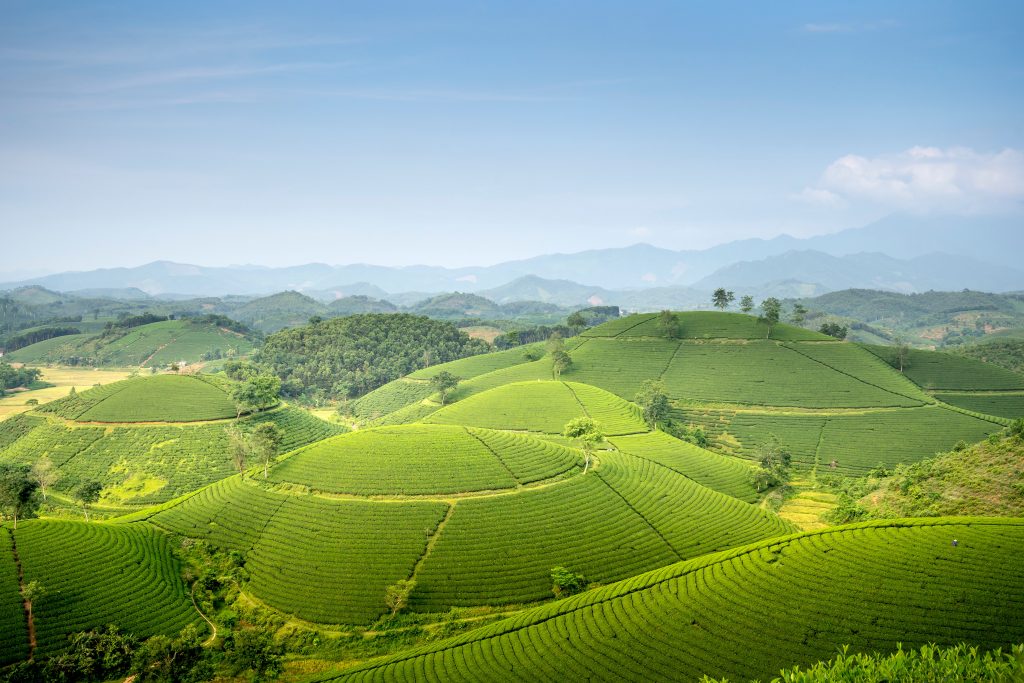
Nepal
Nowhere are heaven and earth as close as in Nepal, Shangri La, and the region where the enlightened Buddha was born.
The spectacular Himalayan mountain range, known as the “top of the world,” is home to the monarchy of Nepal. It is a landlocked nation between Tibet to the north and India to the south, east, and west, with the nearest port being 600 kilometers distant. About 200 kilometers separate the northern and southern regions of the nation.
The nation is divided into three regions: the Terei, which has a tropical climate in the south, the central highlands, which have a lot of valleys and a nice subtropical climate, and the high alpine zone, which has a climate almost as cold as the Arctic, in the north, where the highest peaks on earth are located.
Around 1863, the Chinese emperor gave a small box of Chinese tea seeds to Jung Bahadur Rana, the prime minister of Nepal, as a personal gift.
He entrusted them to one of his close relatives, Colonel Gajraj Singh Thapa, governor of eastern Nepal, and so it was that Nepal’s tea industry made its debut with the first plantations in Ilam and Soktim. The first tea factory, established in 1873, still exists today.
More than 40 tea gardens are now located in the mountains, covering a surface area of roughly 4,000 hectares. The gardens are primarily maintained by cooperatives, but due to the challenging local conditions, only 150 kg of tea are produced each hectare. In areas adjacent to the Indian border, very close to Darjeeling, there are another 50 tea gardens covering an area of about 6,000 hectares and 16 factories producing CTC black tea.
Most of the orthodox black tea is exported (to the EU, Japan, and the United States), CTC and Fannings teas are stored for local consumption.
It is worth noting that currently only two gardens use organic methods of tea cultivation, but that growing in the mountains at altitudes up to 2,200 meters, tea is hardly attacked by pests, and therefore pesticides are very rarely used, the products thus obtained even if they do not have organic certification can be considered as such.
Assam
Northeastern India’s state of Assam is the world’s largest contiguous tea-growing region and is encircled by mountain ranges. It shares borders with Tibet, Bhutan, and China and is bordered by the foothills of the Himalayas in the north. The Shillong Plateau borders Bangladesh in the south while the hilly border with Burma lies to the east.
The state of Assam is largely comprised of agricultural hills on either side of the great Brahmaputra River, which rises in Tibet and during the monsoon season transports enormous amounts of water to the sea. Because of its low gradient (about 100 meters per 600 kilometers), it regularly overflows yearly and floods large parts of the country
90% of the rain falls between April and September at temperatures between 25°C and 35°C and high humidity. In compensation, the period between October and March brings plenty of sunshine and temperatures between 20 ° C and 25 ° C.
All attempts to grow Chinese tea plants in this location failed, but in 1823 a new type of camellia with leaves that were much larger and more vigorous than the Chinese variety (thea sinensis) and that were much better suited to the local climatic conditions was found in this area. Assamic variant is created. Before the first harvest, only three years of growth are necessary. By comparison, a tea garden in Darjeeling takes four to six years.
The first Assam tea, green tea, manufactured with Chinese assistance, was traded in Calcutta between 1836 and 1838. Chinese tea farmers taught Assam growers a lot, and they immediately started making black tea. The world of tea may soon be conquered. In addition to orthodox tea production, CTC tea is also widely produced.
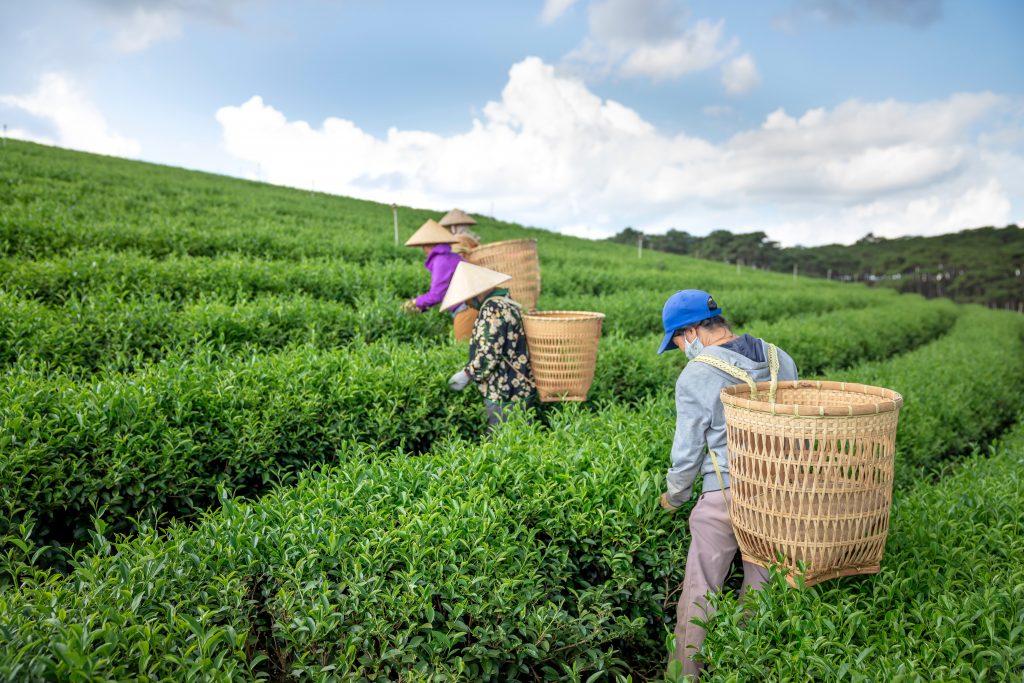
Ceylon: Sri Lanka, Land Of Good Fortune
This lovely island is located in the center of the Indian Ocean, surrounded by various coral reefs. Its previous name during the British Empire was Ceylon.
Tea kept its previous name after Ceylon became independent in 1972 and was renamed Sri Lanka. With nine provinces and 25 districts, Sri Lanka has been a socialist republic with a single president since 1978.
Ceylon tea has influenced cultures started in Arabia, Russia, and England to this day.
Tea has not always been a crucial component of Sinhalese agriculture, though. It is true that tea bushes of the sinensis and assamica kinds were planted in the 1830s, around the same time as tea was discovered in Assam, India; nevertheless, they had little economic value and were solely grown for experimental purposes.
All of the island’s coffee plantations were devastated by the fungus hemileia vastatrix around 1860, after which they were turned back into tea plantations. James Taylor, a Scotsman, worked extremely hard to construct the first tea plantations in 1867. Thomas Lipton of Glasgow constructed lavish tea facilities in 1890, encircled by numerous tea estates.
Dimbula in the west, the Nuwara Eliya highlands, and UVA in the east are Ceylon’s three main agricultural regions. Each geographical area creates its own unique flavors. In Nuwara Eliya, delicate aromatic teas are gathered in January and February, while the Dimbula valley produces its brightest red tones at the same time. In UVA, premium-quality soft aromatic teas with a hint of citrus flavor are produced from June to September.
Indonesia
Since its independence in 1949, Indonesia, despite local conflicts, is still a tropical paradise for both its inhabitants and visitors, with a pleasant climate and 17,000 islands.
It is home to New Guinea, Borneo, Sumatra, and Sulawesi, the world’s second, third, sixth, and eleventh largest islands, respectively, as well as smaller, unspoiled islands that feature a wide variety of flora and fauna. They are also home to some unique animals, such as the orangutan, tree kangaroo, Komodo dragon and rafflesia, the world’s largest flower.
In 1824 the German Dr. Ch. Bernard was given the task of starting a Chinese tea plantation in Java by the government. The initial seeds and plants came from China in early 1826. With Chinese experts overseeing the operation, factories were gradually built and tea was processed according to Chinese methods. The frigate “Algier” brought the first Javanese tea to Holland in 1835 and sold at auction from the same year.
The first Assam plants were also introduced in 1878. By skillfully crossing the two varieties, quality improved, resulting in a real tea boom in 1910. To meet world demand, plantations have since focused on Sumatran tea, whose plantations produce a much stronger, tannic tea than the lighter, more aromatic Java teas.
Due to Sumatra’s climate, a uniform quality of tea is produced throughout the harvest period. The Sumatran tea therefore does not follow seasonality, whereas in Java, premium quality teas are harvested between July and October.
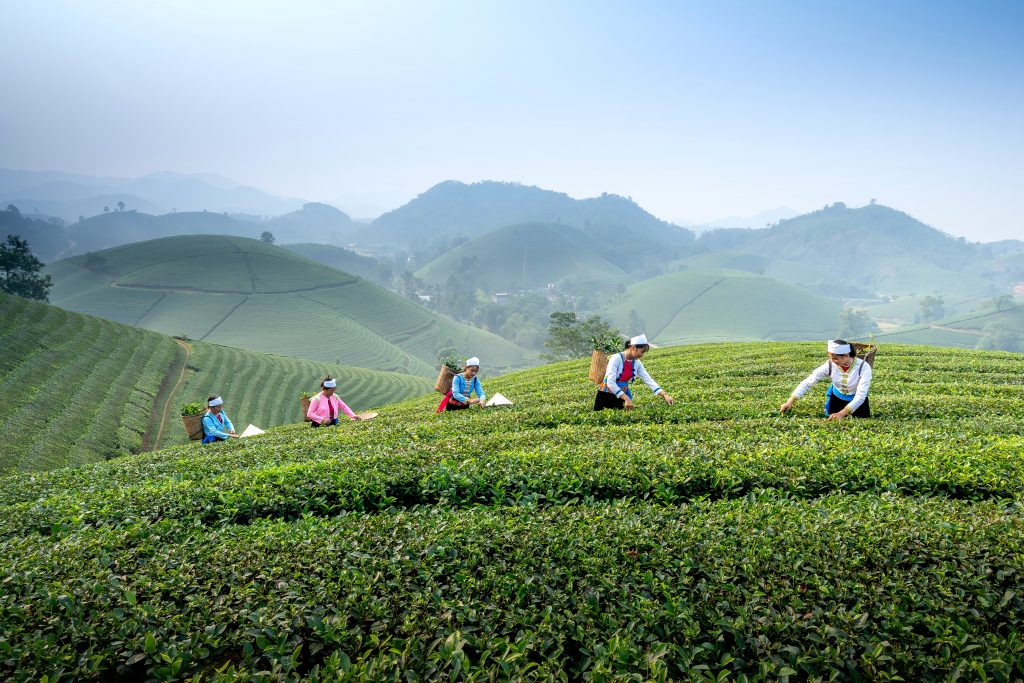
Malaysia
“Selamat Datang: Welcome to Malaysia, the land of tigers.”
The nation comprises 13 federal states, where the population of about 62 percent Malay, 30 percent Chinese and 8 percent Indian live in harmony.
The peninsula with its strategic location and capital Kuala Lumpur has always been coveted by great powers. It has been ruled by Indonesians, Dutch, British, and Japanese, and because of this, different cultures and customs have developed. After the Japanese occupation (1941 – 1945), the Malaysian Union was established in 1946.
The peninsula south of Thailand and the northern portion of the island of Borneo make up Malaysia, which is home to 22.2 million people of various religious backgrounds.
The nation is a well-liked travel destination in part because to its breathtaking beauty. Taiwanese have discovered Malaysia as the ideal source of high-quality tea. Its unique soil, characterized by mangroves and rainforest on the edge of towering mountain ranges, gives tea an unmistakable aroma. Oolong teas from Malaya are renowned and distinctive for their intensely nuanced and enduring scent.
China: Zhong-Guo – The Middle Kingdom
China has been regarded as the global center of culture for many years.
In actuality, Chinese pictography has existed for 5,000 years and is one of the oldest and most sophisticated writing systems.
In 1949, Mao Zedong, a communist, proclaimed China to be a People’s Republic. Jiang Jieshi (Chiang Kai-Shek), who headed the vanquished nationalists, fled to Taiwan.
After Mao’s death in 1976 and under the rule of Deng Xiaoping, China became increasingly open to the West, and it is because of this openness that we have been able to learn about the different varieties of tea produced in the various Chinese provinces. The tea varieties come mainly from 13 Chinese provinces. The country as a whole is divided into 22 provinces (plus Taiwan as the 23rd province) and five autonomous regions.
About 1.2 billion Chinese can boast a tea-drinking culture of about 5,000 years.
Beginning as an aroma, later as a medicine, and ending as a luxury food with a range of benefits, tea has become increasingly important.
There are many conflicting theories regarding the origins of tea, but the first tea master and Zen master Lu Yu (768–824 AD) wrote a book about tea (the Cha Ching – The Tea Canon) that elevated tea to a significant status. The book was later translated into several languages, including Italian by Prof. Marco Ceresa, a native of Lodi and lecturer at Ca’ Foscari University in Venice and director of the Confucius Institute Venice. Tea, which was once solely associated with Chinese culture, gave enormous wealth to the nation. War and corruption spread the secret of tea to the outside world. That is why today we can drink delicious varieties of tea from India, Japan, Sri Lanka and other parts of the world.
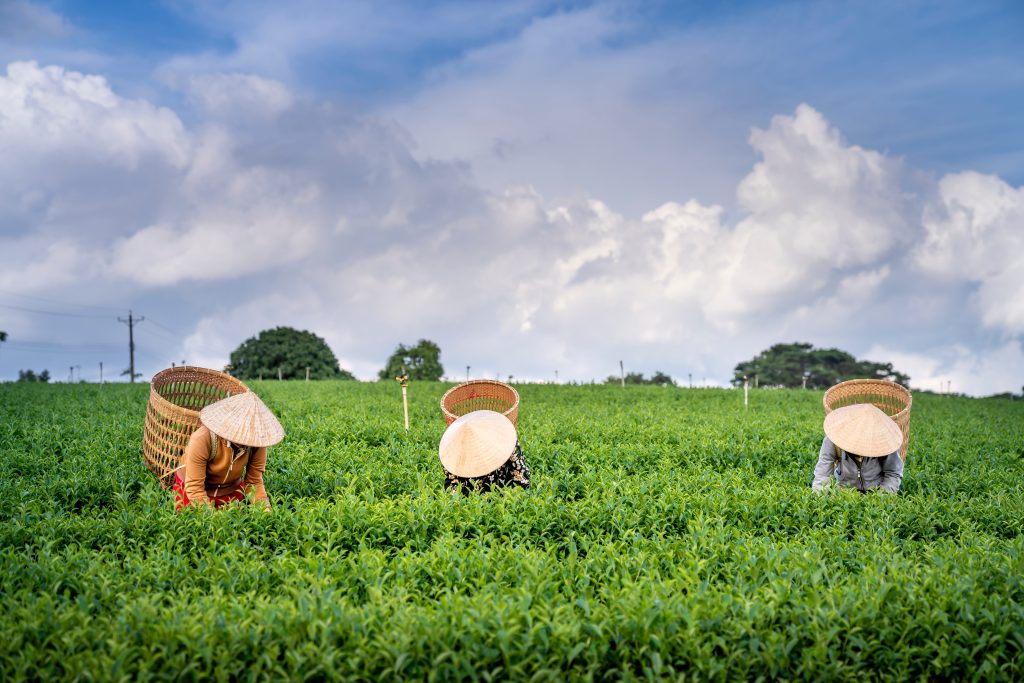
Japan
Similar to the representation of the sun goddess, Nippon has a 2,600-year history. Identical characters can have different meanings in the two countries, despite the fact that the language has developed in its own unique fashion and the typeface strongly incorporates Chinese characters.
The Manchukuo Empire was established in Japan in 1934 after annexing Taiwan in 1895, Sakhalin in 1904, and Korea in 1910. War with China became one of the main goals from that point on. In 1941, it entered World War II and allied with Germany and Italy as the Axis forces. It had virtually all of Southeast Asia under control by 1942.
The Japanese were eventually compelled to submit and return all the territories they had taken since 1895 after the atomic bombs dropped on Nagasaki and Hiroshima.
In spite of its lack of natural resources and dependence on imports for the majority of its raw materials, Japan is one of the world’s leading economic powers today. Japan is again a land of irrefutable beauty…. “the land of the rising sun.”
Shrines, sculptor and Buddhist temples, flower ikebana and tea ceremonies represent man and nature in a harmonious whole. Japan would be difficult to envision without tea. Japanese tea is exported in very tiny amounts and at a relatively expensive price. The majority of tea produced is consumed right away. The first tea seeds were introduced to the Japanese islands in the Ureshino region in AD 805, by Buddhist monks from Zhi Zhe Ta monastery in Tian Tai Shan, Zheyang Province (China) (Saga Province).
At first, tea was brewed according to Chinese techniques, roasted in metal pans (kamairi-cha). Later, because of the presence of numerous hot springs, tea was prepared using steam.
The Japanese revere all good things, including tea.
Formosa, The “Beautiful Land”
This 36,000 square meter island, which is located about 200 kilometers off the coast of the city of Xiamen in southern China, was given its name by the Portuguese (Amoy).
In 1683, China seized Formosa, or Taiwan. The island was thereafter ruled by the Japanese from 1895 to 1945. With the assistance of the US, the nationalist Jiang Jieshi (Chiang Kai-Shek), who had been overthrown by Mao Zedong, arrived on the island in 1949 along with roughly two million other refugees and took over as its political head.
Taiwan was forced to resign from the UN and lost contact with the rest of the world after the US recognized the People’s Republic of China in 1971.
The island is known for its humid, hot, subtropical climate. The country is very mountainous, and thus offers ideal conditions for tea cultivation.
Tea has been grown on Formosa since 1810 and has become the island’s main export, with Japan as its main customer. The first tea gardens were planted in Taiwan in 1650 by farmers from the southern Chinese province of Fujian. The first plantations were built close to Taipei, the current capital.
Today tea is grown mainly in central Taiwan Island (Nantou Province). Some stunning oolong Kao-Shan (highlands) have been developed in its high valleys and tiny family-owned plantations, such Dong-Ding, Ali Shan Cha, Jin Shan Cha, Tikuanyin, etc.
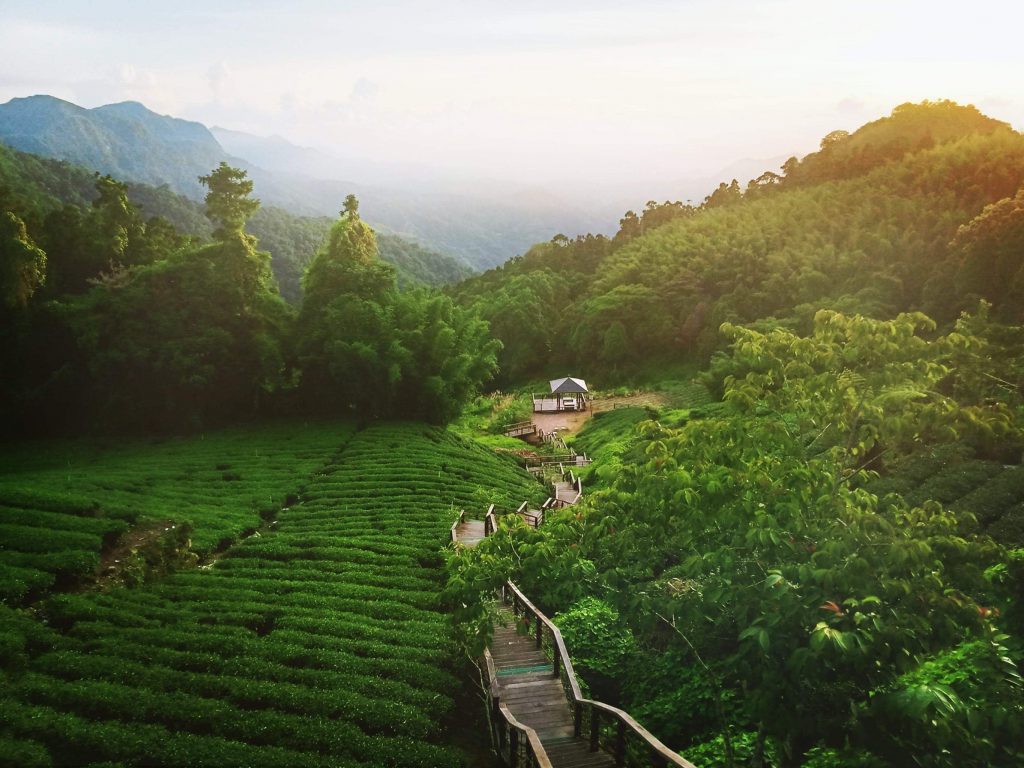
The South American Tea – Mate
Brazil, Argentina, Paraguay, Uruguay, sections of Chile, and Bolivia all have mate as their national beverage. It is an extremely potent Yerba Mate “infusion.”
Scientifically known as Ilex paraguariensis Sant Hill, in the wild it is a shrub about 15 meters tall, but it is grown as a bush to be easily harvested. The leaves and branches are used. The final product is called Yerba Mate and marketed as such; it consists of dried leaves, lightly roasted and ground together with fragments of young branches. The Spanish arrived in the 16th century and began to use this beverage, which was christened then as Jesuit Tea or Paraguayan Tea, and provision was given to the Jesuits, settled in the area, to cultivate it.
At first cultivation proved rather difficult, but it soon became an important pillar of the economy that characterized the Jesuit missions. In 1769 the Jesuits were expelled from these territories, and with their disappearance, the plantations were abandoned and germination and development techniques were lost. It took more than a century to resume their cultivation, and after several studies and failures, with the early 1900s the plantations were started again. Today they are of fundamental importance to the economy of the entire area.
The most traditional way to enjoy Mate is to use a cup called a “Mate” and made from a “calabaza,” a gourd, into which hot water is poured over the leaves, the Mate is then sipped through a metal straw called a “bombilla” that ends in a small welded filter.
Properties of Yerba Mate
South American peoples attributed divine powers and magical effects to yerba mate.
Today it is known that yerba mate infusion, is indeed stimulating and tonic.
Yerba mate is a natural source of energy that encourages mental and physical effort due to the xanthines it contains. Theobromine and caffeine are xanthines, which are substances that stimulate the central nervous system (CNS).
Control and regulate mental and physical effort, making it excellent for athletes or anyone who engage in both physical and mental activity. Restores fatigue by successfully facilitating work and activity. Accelerates heart rate, helping to lower blood pressure. It activates peristalsis in the intestines, and acts as a stimulant for stomach contractions. It is a source of B vitamins, which help to release and make the most of the energy in food. In Brazil, it is used to combat depression, fatigue and obesity. The chopped leaves are also used in topical application to the skin to treat ulcers, due to the high tannin content, which generates a cicatrizant.
There are several nations of Europe where it is used to aid weight loss, to combat physical and mental fatigue, and to combat depression and headaches.
South African Tea – Rooibos
Rooibos is an infusion prepared from the leaves of the same-named plant, which is a member of the legume family. It is sometimes referred to as redbush or African red tea. The word “rooibos,” which is derived from Afrikaans, one of South Africa’s official languages, means “red bush.” Only the Cederberg region is home to this species of plant. The locals were the first to create the drink and take use of its advantages.
Thanks to the intervention of a South African settler of Russian descent who began its mass manufacturing, rooibos was first imported into Europe. Rooibos started to spread throughout Africa and the rest of the world after that. It is still considered as South Africa’s national beverage.
What, though, makes African red tea so unique? Rooibos looks a lot like any other type of tea. Making the beverage involves steeping dried and powdered rooibos leaves in hot water. Harvesting the leaves and twigs, chopping them using wooden pestles, and fermenting them are the traditional preparation steps. The result of the infusion is a naturally sweet-tasting liquid that is amber-red in hue. One should have rooibos without sugar to enjoy it to the fullest.
In contrast to black and green tea, rooibos is naturally devoid of caffeine. Additionally, it has a very low tannin concentration, which enables the drink to keep its sweet flavor even if you don’t drink it right away or neglect to steep it. Natural components essential to the body, including vitamin C, magnesium, phosphorus, iron, zinc, and calcium, are present in rooibos.
The National Food and Nutrition Research Institute’s scientific investigations have established that rooibos’ antioxidant content is comparable to that of black and green tea. Within an hour of ingesting rooibos, there is a significant increase in substances in our bodies that can act against the formation of free radicals. Because of this, rooibos is an all-natural panacea that may be consumed by anybody, including those who are sensitive to the negative effects of caffeine.
